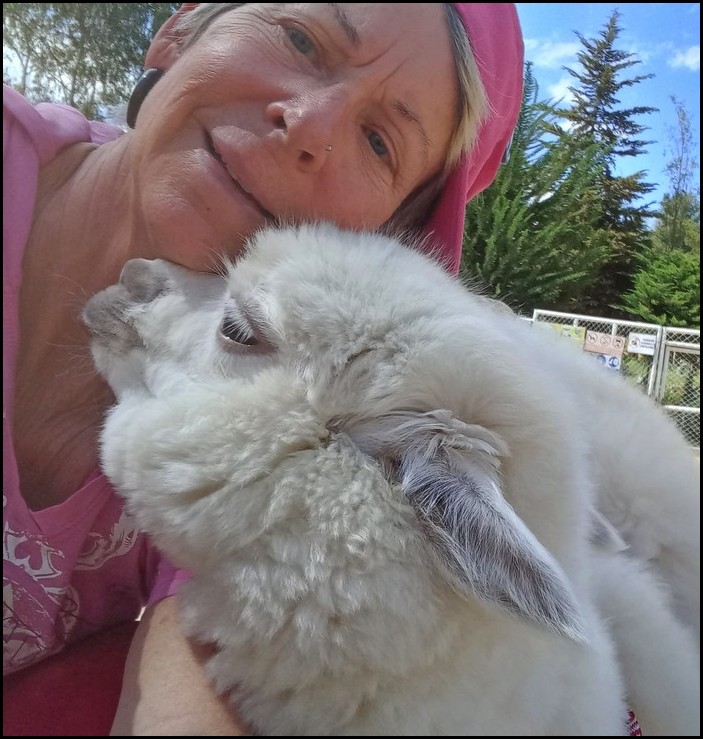
15 Interesting Facts about Llamas and Alpacas
When I was a young girl of about eight or nine years old I managed to win some sort of contest or drawing. For my prize I was allowed to choose one stuffed animal out of a huge collection of stuffed animals of all sizes, shapes and species.
I was astounded simply to have won a contest for the first time in my life, let alone being allowed to choose a great prize. It took me ages to decide among all the amazing choices, but finally I selectd the largest animal there: a huge, white wooly llama.
I’d never heard of a llama before that, but I certainly cherished my huge white llama prize. Ever since then I’ve been enamored of llamas.
So one of my biggest dreams about exploring South America was to finally meet real live llamas in person. The first ones I encountered were in the high Andes of Ecuador, near the Inca ruins Ingapirca, a couple hours northwest of Cuenca.
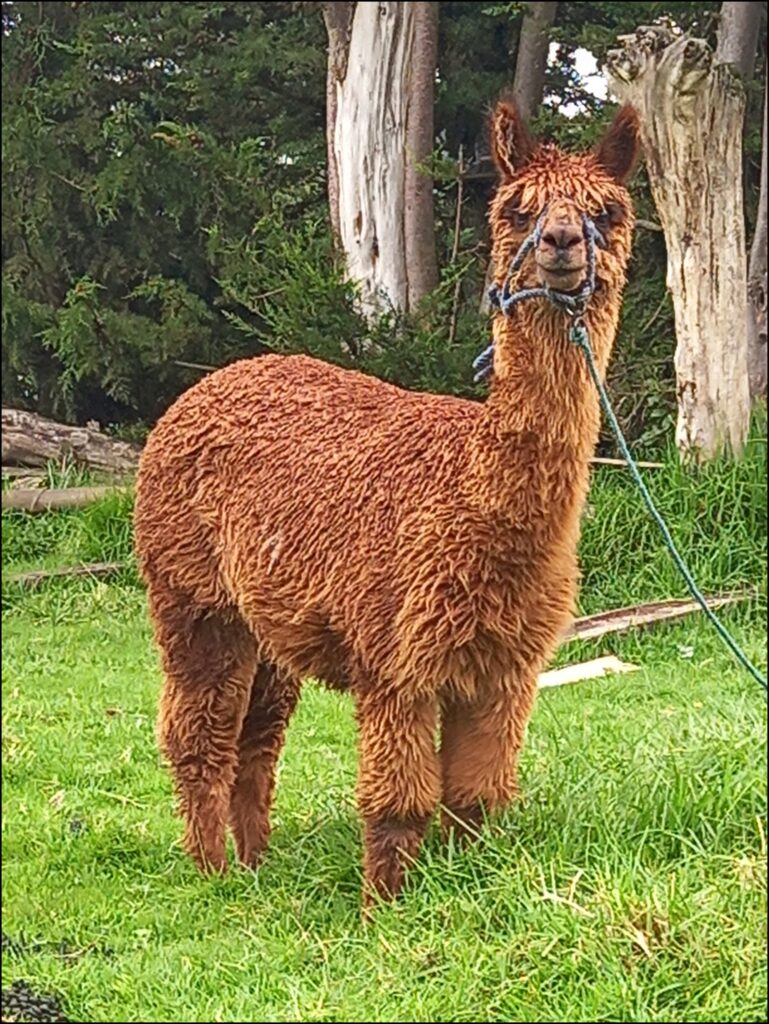
While visiting the ruins, I stayed two nights at a historic church mission in a very rural mountain area. Right on the property, to my great delight and surprise, were two big llamas. Well, actually, I found out they were alpacas, but never mind, I was smitten.
It wasn’t until much later that I was eventually able to distinguish between llamas and alpacas…and their third cousin, the vicunas. But during seven months of travels in South America thus far, I’ve encountered many, many alpacas and llamas, as well as a few vicunas.
I’ve seen them walking down town streets with their indigenous owners. I’ve gazed at them from bus windows grazing in large flocks in high Andes plateaus. I’ve come across them while hiking in mountains. And I’ve met them in corrals at several textile / weaving centers.
Through all these experiences I’ve learned a lot about llamas, alpacas and vicunas. And I’m now happy to say that I can recognize each species on sight without any problem.
In this article I explain many interesting facts about these beautiful high-Andes animals, of which I’ve been enamored my whole life by a simple instance of fate…
1. Llamas are related to camels
I’d never really thought about what species of animals llamas belong to. If I’d had to guess, I would have guessed they were related to sheep.
So I was mighty surprised to learn that llamas, alpacas and vicunas are all camelids, aka members of the camel family. There’s a fourth South American cousin, the guanaco. Sometimes these animals are referred to as the ‘Camels of South America’.
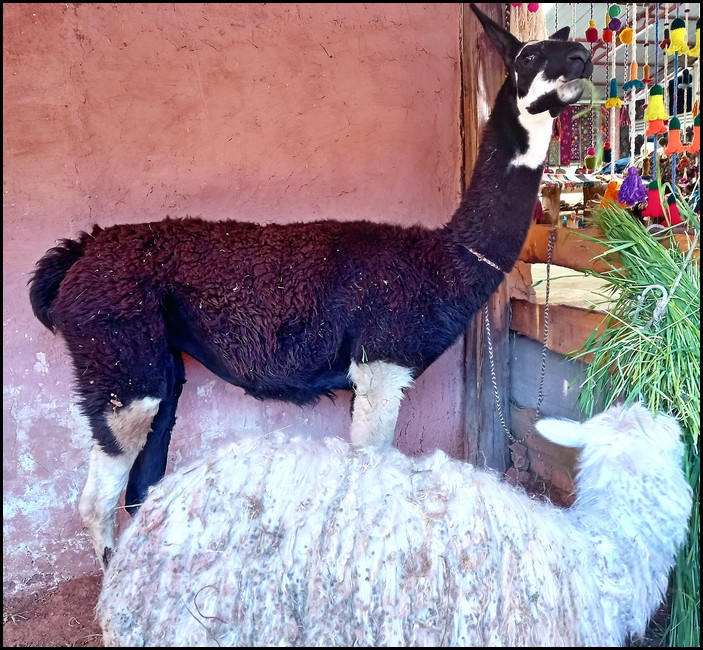
2. Llamas are the largest of the South American camelids
Of the four species, llamas are easily the largest. They have long, shapely legs and long necks.
They genrally stand 5 ft 6 inches to 5 ft 9 inches tall, but can reach 6 ft. Basically, they’re the same height as humans. They generally weigh 280-450 pounds / 130-200 kgs, much heavier and meatier than most people.
Alpacas, in contrast, have much shorter legs and look more stocky, at least when their wool is long and unshorn. They stand and weigh 105-185 lbs / 90-120 kgs.
Vicunas are the smallest. They have more or less the same proportions as llamas, but on a smaller, more daintly scale.
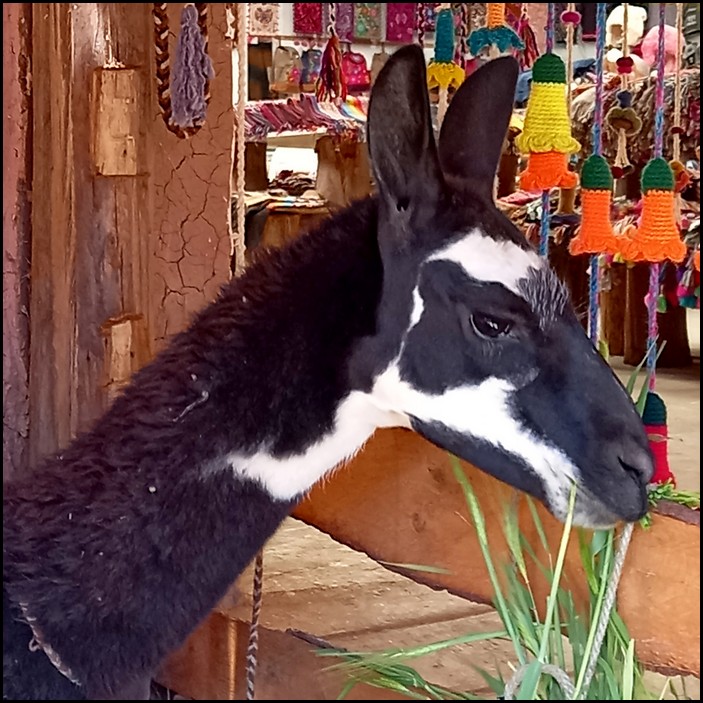
3. Llamas and alpacas can be distinguished visually by their faces, ears and height
When telling people how to distinguish between llamas and alpacas most locals will point out the llamas very large ears, which tend to stand straight up from their heads. While that’s true, I’ve found this to not be the easiest way to recognize llamas.
For one thing, llamas often hold their ears backwards rather than straight up. Secondly, alpacas also holdtheir (smaller) ears straight up too, making them look like llamas to me.
I’ve found an easier way to distinquish between the two is by the shape of their foreheads and faces. Llamas have a long straight top of the head, that runs down in a strong, straight line from their ears to their noses, much like a horse.
Alpacas have a head shape than curves down, like a ski-slope nose on many humans. Their snout is shorter and more petite than llamas.
Other distinquishing features are llamas proportionally longer, less wooly legs; their height (though that can get confusing with young llamas); unusual colorings; and less wooly faces. Alpacas have proportionally shorter, stockier legs, generally shorter bodies (again, this can be confusing when considering different aged animals) and usually heavier wool.
Of course, this can also get confusing when the animals are freshly-shorn.
To me, the most distinguishing feature is the llamas straight, long faces vs alpacas’ shorter, curvy profiles.
4. Llamas live 15-30 years / average 20 years
Most llamas live an average of 20 years, but their normal lifespan ranges from 15 to 30 years. That’s a pretty similar life expectancy as dogs and cats.

5. Llamas come in some very unique colorings
While all alpacas come in one solid color, ranging from white to shades of brown to black, several llamas I’ve met have some crazy color patterns. I’ve seen llamas with black and white ‘poka dots’, with mottle, multi-colored wool, and with wide stripes on parts of their bodies.
6. Llamas hum!
Wow, they hum!
As if llamas and alpacas weren’t adorable enough, they also have the charming habit of humming. The first time I heard an alpaca hum I was smitten all over again.
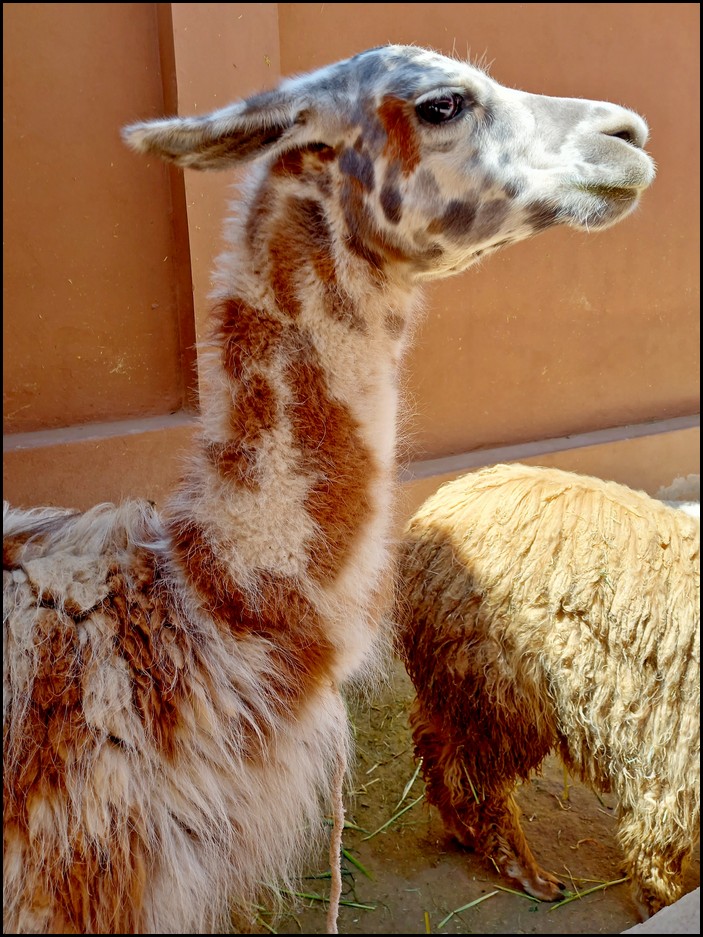
7. Llamas spit when agitated
Luckily, llamas nor alpacas bite. Instead, when they get irritated, they spit. Usually directly into their irritant’s face.
Since I love to get up close to animals, try to pet and be-friend them, I have been spit in the face by llamas several times. Luckily, their mouths have usually been empty, so I got little more than air blown on me. But I have had mucous-y grass mess spat on my face and shoulders once or twice as well.
I’ve also witnessed them stomping one leg at me as a warning to stay back.
Llamas tend to be less friendly and cuddly with humans than alpacas. They’re more standoffish and stern.
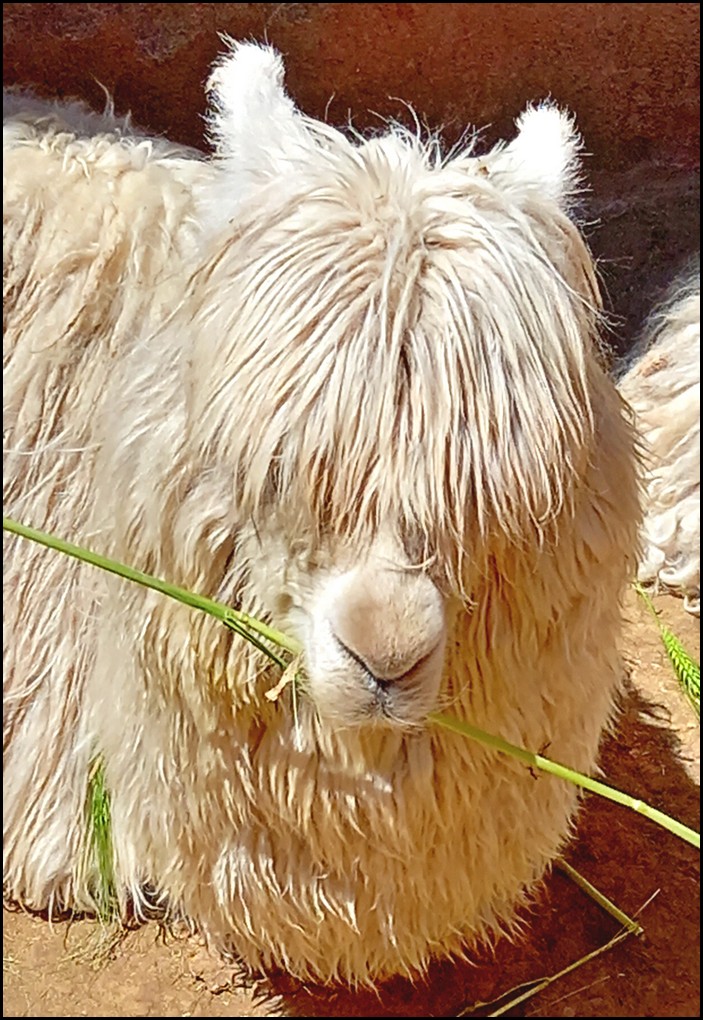
8. Llamas are herbivores with digestive systems like cows / three stomachs & regurgitate & chew cud
Llamas, alpacas and vicunas all graze in fields, just like cows and sheep. They also have a digestive system quite similar to cows, with three stomachs to process their food (as opposed to four stomachs in cows).
Like cows, they also regirgitate their food and chew on the cud.
9. Llamas were traditionally used to protect other animal herds
Not only are llamas the largest camelid around, they tend to be a bit aggressive. For that reason, indigenous herders used llamas to help protect their flocks, much like sheep dogs are used in other countries.
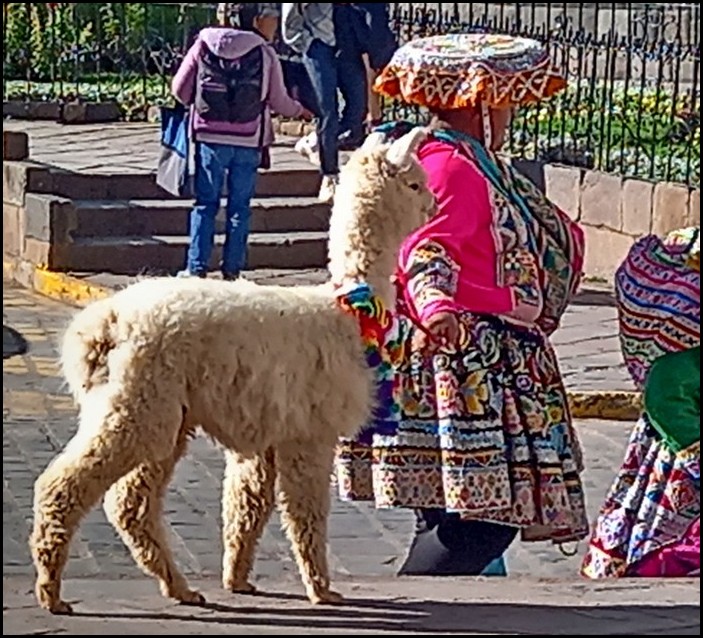
10. Llamas were also traditionally used as pack animals
Again, because of their larger size and strength, llamas were traditionally used to haul heavy loads around the Andes Mountains, as far back as 4000-5000 years ago by various indigenous Andes cultures.
Horses, donkeys, mules, sheep and cows are not indigenous to South America. They were brought to the continent by Spanish conquistadors in the 1500s. Prior to that time, for thousands of years, llamas were actually the largest animal in the Andes.
Llamas can comfortably carry 25-30% of their body weight. That means a smaller llama could carry 70-85 lbs, while a larger llama could carry 112-135 lbs. That’s certainly more than most adult men could carry.
11. Llamas know their limits – will only carry a comfortable load
Apparently if llamas are loaded up with a weight to heavy for them to carry, they refuse to walk anywhere. They simply fold their legs under then and sit down. Smart!
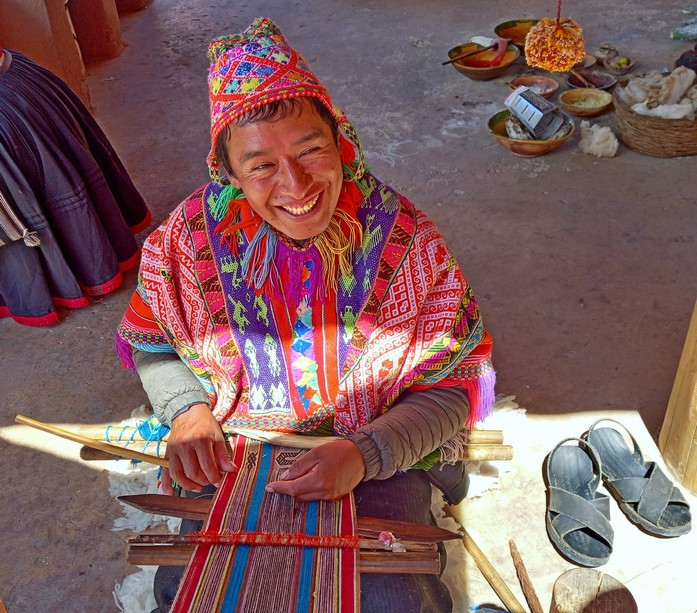
12. Llama, alpaca and vicuna wool has been used for fabrics and clothes for over 6000 years
Many indigenous cultures over the centuries have been very skilled weavers. They make all sorts of practical things from the wool of llamas and alpacas. They weave ropes, bags, hats, scarves, large multi-purpose cloths and most of their clothes.
The weavers tend to create intricate patterns in multiple colors, either in several neutral tones or in a mix of vibrant colors. Many tribes and particular Andes villages are renowned for their weaving skills and beautiful textiles.
They create everything by hand from scratch. That includes sheering the animals, sorting and combing and refining the wool, making dyes from native plants, dying the wool, spinning the yarns, setting up the looms and then finally weaving the fabrics.
The wool of all these animals is smoother and silkier than sheep wool. Of the three camelids, llamas have the coarsest wool, though it’s pretty soft and fine.
But alpaca wool is considerably finer, softer and silkier. Baby alpaca wool is ultra fine.
And vicuna wool is considered the finest and silkiest of all. It’s also extremely hard to come by, and thus incredibly expensive. There are several reasons it’s so rare. First, vicunas are wild. Secondly, there are relatively few vicunas. Finally, shearers can only shave off a small portion of their back wool. Otherwise, they might freeze in the cold Andes climate.

13. Llama wool is lightweight, warm, water-repellent, very soft
In addition to llama and alpaca wool being silky soft on the skin, it’s also lightweight, insulating and water-repellent.
Knit and woven clothes and fabrics made from these South American wools are considered some of the finest (and thus most expensive) in the world. They’re on par with cashmere (from Cashmere goats) and (from sheep).
14. Today 65% of all llamas live in Bolivia
Of the currently estimated several million llamas living in the world, it’s reported that 65% live in the high Andes regions of Bolivia. Most others live in Peru and Chile, while some now live in North America and Europe on llama ranches.
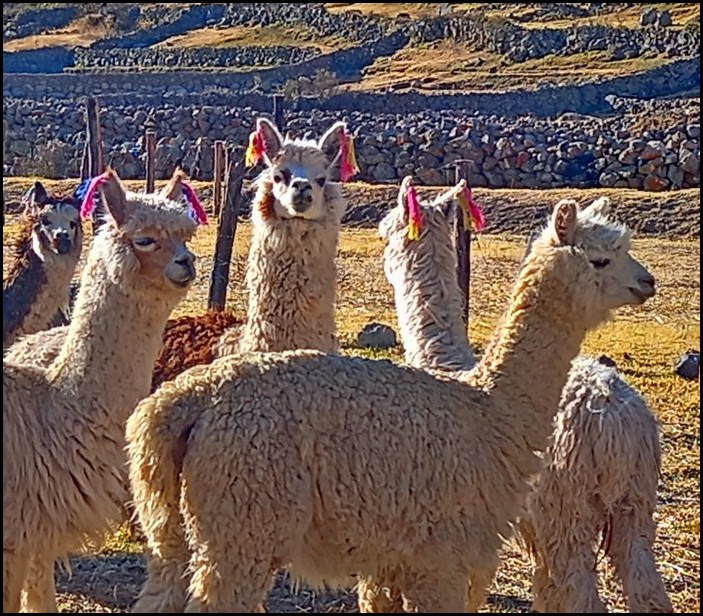
15. Nowadays 95% of all alpacas live in Peru
There are currently estimated to be about four million alpacas in the world. 95% of them live in the high Andes regions of Peru.
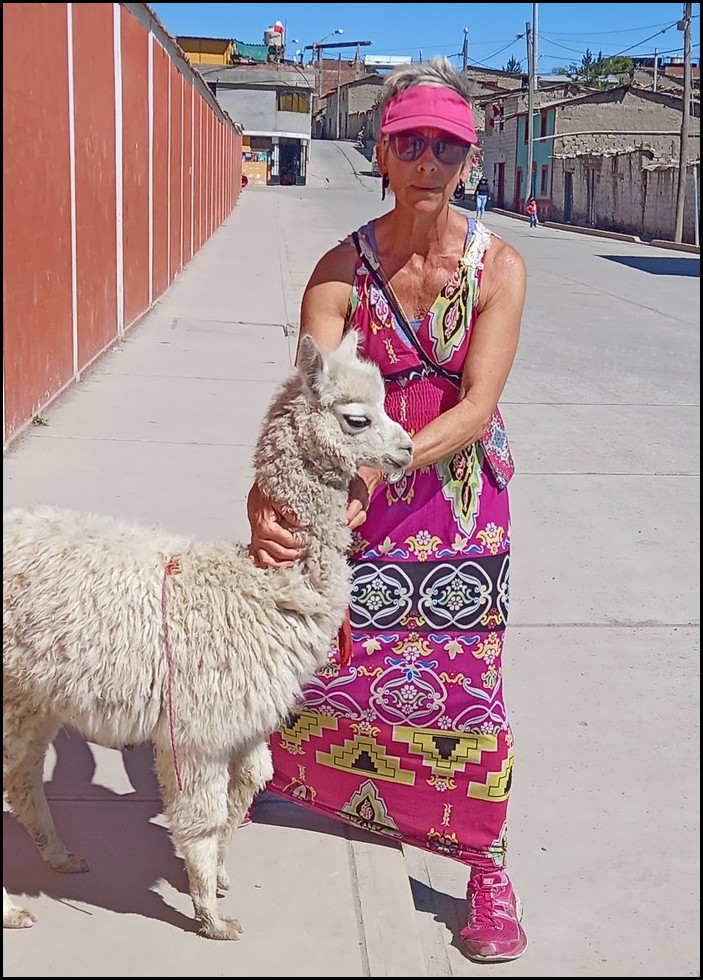
Conclusions
I hope you’ve enjoyed these interesting details about South America’s lovely llamas and alpacas. I know it’s been quite fun for me to learn and researching about my childhood ‘hero’ animal, and even more exciting to meet many in person here in South America.
===========================
You might also enjoy:
Delicious Fruits of South America
13 Things I Love about South America
============================












 Hi! I'm Lash, an American nomadic world traveler who's been traveling solo since 1998. I’m passionate about traveling the world nomadically and then sharing it all with you. I hope to inspire you to travel the world, to entertain you with tales from the road, and to help you reach your travel dreams. Welcome!
Hi! I'm Lash, an American nomadic world traveler who's been traveling solo since 1998. I’m passionate about traveling the world nomadically and then sharing it all with you. I hope to inspire you to travel the world, to entertain you with tales from the road, and to help you reach your travel dreams. Welcome! 




1 pings
33 Highlights of my South American Journeys - LashWorldTour
2024/01/21 at 10:54 am (UTC 8) Link to this comment
[…] Much to my delight, I met lots of llamas and in many different places. I also met alpacas, vincuñas and guanacos, all cousins of llamas. I discovered that it’s actually alpacas whom I’m so smitten with. I learned a lot about all these wonderful animals and wrote about them here. […]